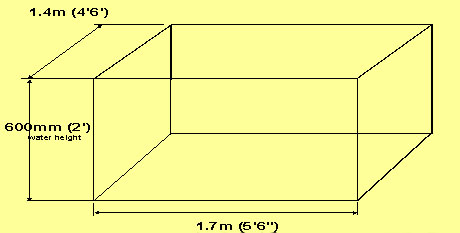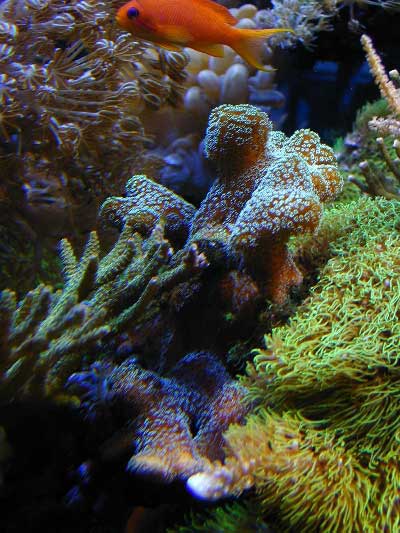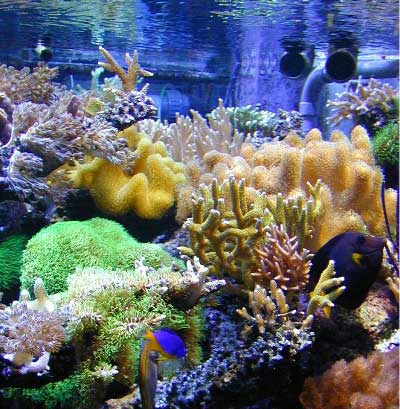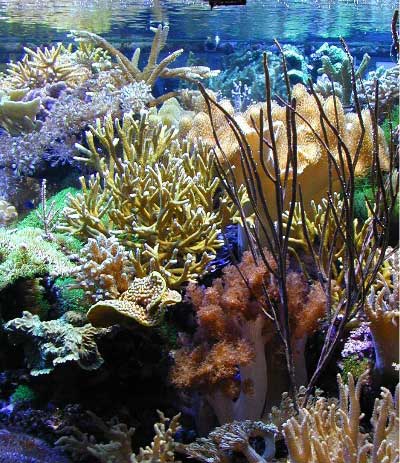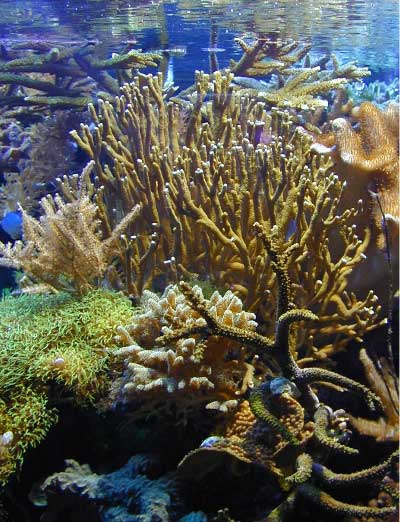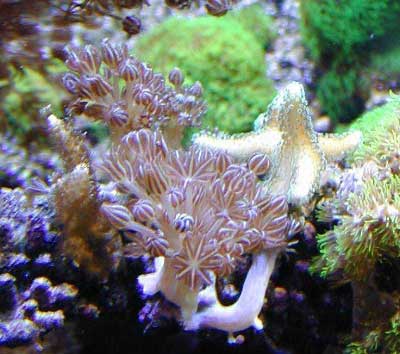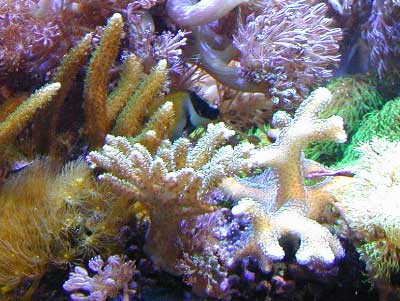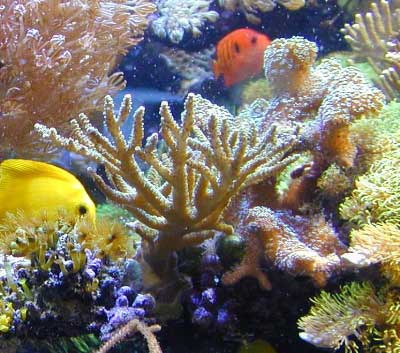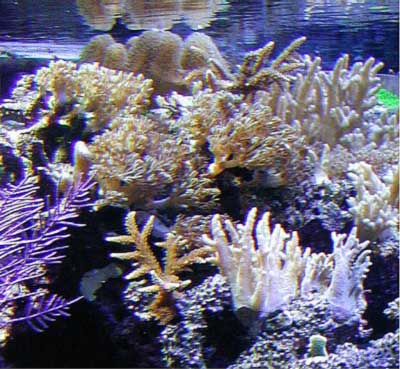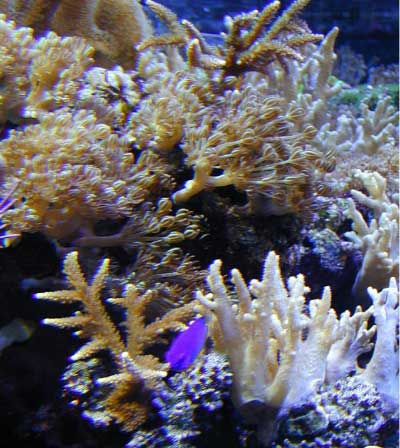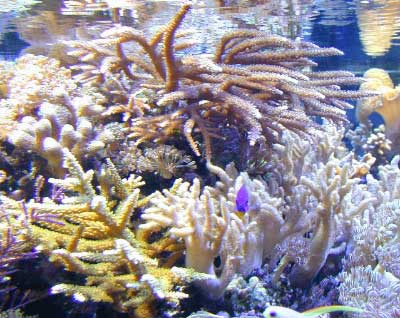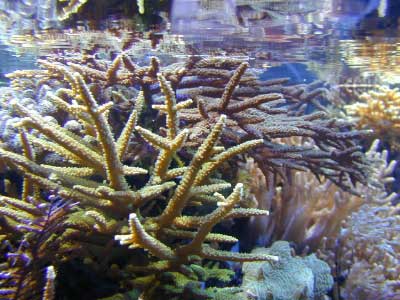
|
|
|
Martin Lakin's (AcroporaUK) Reef Tank
Background: Firstly, let me introduce myself. My name is Martin Lakin, a Chartered Engineer, living in UK. I feel very honoured to be asked by Reefkeeping Magazine and Reef Central to write about my tank. My initiation into fish keeping started some 30 years ago as a result of winning a goldfish at a fair. After keeping freshwater tropicals, I moved into the fascinating marine hobby roughly 24 years ago, starting with a 20 gallon set up. In the early 1980s, I strived to emulate the amazingly successful reef tank that Terry Evans had created in his shop at Romford, England, and set up my first 100+ gallon system with metal halide lighting. Some 6 years ago I met David Saxby and was again mesmerised by the success he was having, especially with SPS corals. Whilst I wish to express my gratitude to Terry, David and many of the other people who have helped me over the years, there is a very important lesson to be learned here: learning from others is critical to success; judge the quality and credibility of advice only upon observing the quality of the advisor's set up.
Aquarium Profile: The tank sits in a small room which has been created adjacent to our living room so only the front can be viewed from our lounge. The system is 3 ½ years old. Access to the front sections of the tank can be gained through a detachable panel, and all the operating equipment is located in the room directly behind the tank. The tank houses a vast mixture of all types of corals, anemones and a large number of fish.
The reef structure was created using live rock, and extremely large pieces of dead branching Acropora, etc. Using old pieces of coral from our fish-only tanks is very effective; however, purchasing newly imported dead coral is not environmentally friendly, and the use of rocks threaded onto pipes or tied together using cable ties is just as good in creating an 'open reef environment'. I have also created internal shelves out of 10mm glass to support a structure at higher levels in the tank, and avoided filling the entire tank with rock. This enables me to maximize the water capacity and available swimming space for the fish.
Plumbing and Circulation: In the ocean, water moves 'in blocks' and I attempt to re-create this motion within the tank. Having a single pump blasting water out is inappropriate, while the use of numerous pumps and spray bars is a more effective way of displacing the water. Please do not attempt to put power heads within the living rock structure; consider how you will get to it for maintenance. I've also seen the bottom of tanks drilled forming part of a closed-loop circulation system. In my opinion, this is a very dangerous practice. A defective joint can result in disaster, and can empty all the water on the floor.
The majority of the water is returned back to the main tank display via two 30 watt ultraviolet (UV) sterilizers connected in series; the remaining water passes through a bypass valve. The bypass has been fitted since it is understood that pumping water too quickly across the UV reduces its effectiveness; it also allows for isolation of the equipment for maintenance. Lighting: Natural light is provided via a 5' x 4' skylight made from twin-walled polycarbonate sheeting. Artificial light is supplied by six 'home made' 250 watt metal halides and one actinic 03 fluorescent.
Whilst I have no scientific proof to verify this, many of the tanks I have seen with good coral growth have used a mixture of 10K and 20K lamps, and I am aware that some companies are now manufacturing units which have both types of lamps in the same unit oriented parallel with each other, providing an excellent blended output. All of the metal halides are controlled by separate time clocks and contactors. Over the years, I have found that connecting these luminaries directly into the timers can cause the switching mechanism to become defective.
Looking at some of the other superb tanks around the UK, if I was reappraising my lighting and starting again, I would use blended 50% 20K and 50% 10K and base it on about 1000w/m2 on a 2' or 2'6" deep tank.
Sumps: The tank now has two sumps; the one below the tank holds approximately 50 gallons and is now used as a nursery for coral frags (not shown in the earlier photograph). In my view, provision of a coral nursery facility is important, since with successful tanks you will, without any question, have to consider what to do with your surplus corals. Many of our tanks do not resemble a reef, nor does mine, and this is largely due to keeping so many different types of corals. In nature, for the same given area, there would be far fewer colonies within the same given area, but due to space limitations and the desire to keep different species, many of us keep a larger variety of corals, and we have to prune them much like a gardener does. I'm sure if I stopped pruning the tank, and left it for 10 years, there would only be half a dozen or so corals remaining. Pruning the tank also enables the distribution of coral cuttings to other aquarists and public aquaria, fragments which seem to be much hardier than specimens taken from the wild. I have found one of the most effective ways of mounting the coral frags is by using McDonald's McFlurry spoons. If the end is cut off, you have a perfect square tapered shaft which fits just nicely into the square profiled egg crate that I use in the sump. I should also mention the egg crate is supported on 6 wine glasses. Just drop the frag into the top of the shaft and away you go! My kids think this is great, and I now have to ask the kids if they want to go out for a McDonald's, rather than the other way around. The second sump (108" x 30" x 36"), which is made from polypropylene and is totally encased with 2" polystyrene insulation, has only been added within the last few months. The aim of adding an additional sump was to further stabilize water conditions, especially relating to temperature. Prior to its addition, the temperature could fluctuate by about 2°C in a day, but since the new sump addition the temperature only varies about ½°C during a day. At this point, nothing is in the sump other than water; however, I am considering adding some live rock for supplemental biological filtration in the future. The sump has a turnover rate close to 500 gallons/hour.
Cooling/Heating: There are two 300 watt heater/thermostats in the sump. Their integral thermostat is used as a 'safety' cut off and set at 28°C. Both are connected to a digital thermostat with a set point of 25°C, so that if the digital thermostat becomes defective, their integral thermostat will shut them down. The cooling equipment is operated by a second separate digital thermostat, with a set point 1°C higher (26°C), to prevent the heating/cooling equipment from working against each other. It is only on a very cold winters' night that the heaters have been needed, and I suspect that with the addition of my new large sump they may not be needed at all, although they are still there just in case.
Calcium Supplementation: In my consideration, the combination of the use of both the Deltec kalkwasser stirrer and the Deltec CO2 calcium reactor has yielded the best results. At the time of taking the photograph below, I was in the process of upgrading the stirrer to meet the ever-increasing calcium demands. I also measure the alkalinity of the water coming out of the reactor, and typically aim for a reading of above 30 dKH at all times. Prior to the effluent entering the tank, this cascades its way down through a container filled with coral gravel which aids in knocking any spare CO2 out of solution.
Maintenance & Feeding: Approximately 10% of the water is changed every month. I was told years ago that it takes time for salt water to mix properly and to become less 'reactive/harsh', so I always mix the water up 3 or 4 days before I need it, and use an air pump to agitate that water during the mixing period. Having recently read an article by Ron Shimek, on the accumulation of trace metals, and the potential for substrate/rock to soak them up and subsequently leach back out, I have siphoned out as much of the accessible substrate media as I could and replaced it. The skimmer is cleaned once per week manually, as my model has not been fitted with the self-cleaning kit that is available. I would suggest that anyone who is unable to find time to clean their skimmer on a regular basis, or has the equipment installed in their living area of their house should look at automated equipment, since as a result of their extremely high efficiency, they produce copious amounts of extremely pungent protein (far more than any of my previous skimmers). More frequent cleaning regimes also improve the skimmer's effectiveness. At least once per fortnight, while the venturi pumps are working, I twist a small metal drill bit into the venturi inlet to remove any accumulation of dried salts. Metal halide lamps are changed on a rotational basis every year; about every 6 months the reflectors on the inside of the metal halides are given a clean/polish and every 3 months the glass on the luminaries are cleaned. Every few weeks any accumulations of dried salts around the top of the tank are removed, as any 'clumps' falling into the tank and landing on corals can be fatal or at the least, very irritating. The ultraviolet lamps are replaced every 6 months, along with the actinic fluorescent tube. Periodically, the inlets to the pumps and spray bars are cleaned by removing encrusting algae, etc. I use lime scale removers (the liquid you can buy from the supermarket to de-scale kettles, etc.) and it's effective, but you must ensure that the equipment is thoroughly cleaned with freshwater before putting it back in service. An aqueous iodine solution (Lugol's) is added to the system using a 50% strength (needs to be kept in the dark & cool) at the rate of 4 drops every 4 days for 400 gallons. I use a Salifert 1ml syringe for the dropper and mix with a jug of RO water. This is added to the tank at night, over about a 12 hour period, using a dripper system by Kent Marine. Although I add this at night, I'm not sure if this makes any difference. 20ml of strontium solution (Two Little Fishies) is added every week. The fish are fed frozen Mysis shrimp, fine mussel and cyclops three times per day, along with the occasional use of flake food. I also use freeze-dried Nori by placing a couple of strips to a lettuce clip, every couple of days. Ozone is used occasionally with 200mg injected into the skimmer for approximately 10 hours. Make-up Water: All the water added to the system is cleansed using an RO unit which contains DI resins in the last chamber. The unit's prefilters (5 micron), carbon filters and de-ionizing media are changed every 6 months or so; I also use a digital TDS meter, to check the efficiency of the system. Roughly every 3 days my RO unit is turned on to fill a 10 gallon storage container. A small powerhead with a restricting tap, pumps the fresh water into the Deltec kalkwasser stirrer at a slow 'dribbling' rate. The powerhead is controlled by a float switch in the sump and two time clocks, the first time clock ensures activation, which results in the pump running for roughly 20 seconds. The second timer ensures that, regardless of whether the float switch is calling for it to come on, top up water only goes into the tank during the night and early hours of the morning (i.e. when the pH is low). Inhabitants: Relative to many of the other reef tanks I have seen, my system holds a vast number of fish (which I believe has only been possible due to keeping the phosphate levels down, by using Rowaphos™). I feel that it is important to include lots of herbivores within the collection, which includes Chevron, Yellow & Purple tangs. In my view, a reef tank would not be complete without Anthias; however, great care is needed with these fish, as they must be provided with the correct type of food, especially when first introducing them into the tank. Whilst I understand that cyclops is a fresh water food, it is irresistible to marine fish, especially Anthias. This food source is very, very small in size, shall I say planktonic, and the fish spend a much longer time eating, which is more akin to their natural feeding habits. Although the tank originally housed some Foxfaces, I have found that they are good for eating algae, including Valonia, but can be problematic when they become larger as mine eventually began eating some of the soft corals.
* I only recommend Moorish Idols for large tanks & where they can be fed at least 3 times per day. Additionally, the Foxfaces shown in the photographs above are now removed; they became too large and eventually started to eat the soft corals. Tips: I feel that measuring of water conditions is a maintenance chore that is all too often overlooked. I once went through a period where the corals were not happy; something was wrong, and it took ages to find out what it was. Eventually, the problem was determined to be a defective hydrometer. While I thought my tank was running at 1.025, in fact, it was about 1.035! I cannot stress enough: an accurate hyrdrometer is imperative. Models are available to within 0.0005° accuracy. Unfortunately, these instruments are extremely fragile, and perhaps the most effective way of using them is to have a 'daily' cheap robust instrument for periodic checking against the more expensive and accurate instrumentation.
All photos courtesy of Jeremy Simmonds. Feel free to comment or ask questions about my tank in the forum for the online magazine. |




